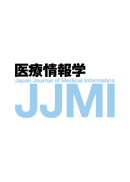All issues

Volume 29 (2009)
- Issue 6 Pages 235-
- Issue 5 Pages 191-
- Issue 4 Pages 149-
- Issue 3 Pages 99-
- Issue 2 Pages 53-
- Issue 1 Pages 3-
Volume 29, Issue 6
Displaying 1-4 of 4 articles from this issue
- |<
- <
- 1
- >
- >|
Original Article-Notes
-
Y Maekawa, A Shiozaki, Y Majima2009Volume 29Issue 6 Pages 235-243
Published: 2009
Released on J-STAGE: March 06, 2015
JOURNAL FREE ACCESSMost nurses suffer from some lower back pain (LBP). The load on the lumber region in nursing practice depends on a patient's condition and situation. So we regard it as the load of nursing practice, and suggest visualizing the load on the lumber region for nursing management. This study focuses on “twist” which is one of factors of LBP. We measured the twist angle of the lumbar region and the surface electromyogram (EMG) in three methods of transferring a patient from a bed to a wheelchair. Experimental subjects were seven women in their 20s and 30s who had learned the transferring technique. Measurement was performed using TRIAS system software (DKH Co., Ltd., Japan). The obtained signal data were analyzed using software (Matlab; The MathWorks, Inc.). We compared three methods divided into four motions according to purpose. Results of visualizing the differences of the load on the lumber region by twist angle, twist angular velocity and twist angular acceleration in each method could indicate nursing practice of less load.View full abstractDownload PDF (560K)
Original Article-Technical
-
Takeshi Ozeki, Masumi Ochi, Takahide Kohro, Aya Ebihara, Hitoshi Ikeda ...2009Volume 29Issue 6 Pages 245-254
Published: 2009
Released on J-STAGE: March 06, 2015
JOURNAL FREE ACCESSThe objective of this study was to evaluate the efficacy of the Integrating the Healthcare Enterprise (IHE) Echocardiography profile in an environment that included legacy information systems. For this study, we developed an Ultrasound Image and Report Management System that was capable of supporting the IHE echocardiography profile. We then implemented this system at the real clinical environment and integrated it with the existing legacy hospital information system, department system, and picture archive and communication system (PACS). A gateway interface was used to convert the proprietary protocol and data from the legacy systems to support the standard HL7 data format and DICOM connectivity used in newer systems. After a year of operation, we evaluated the efficacy of IHE connectivity by collecting questionnaires and performing interviews to compare system performance before and after the integration. The assessment showed that IHE connectivity provided greater accuracy for measurement data as well as for patient and examination information on the report. The conclusion was that IHE connectivity is effective in environments that mix new standards-based systems with existing legacy information systems.View full abstractDownload PDF (416K) -
S Takaoka, N Obana, M Hamada, K Uehara, T Imamura2009Volume 29Issue 6 Pages 255-264
Published: 2009
Released on J-STAGE: March 06, 2015
JOURNAL FREE ACCESSSometimes social reaction to incidents with health and medical risks grows unexpectedly Especially for stakeholders gripping on risk management, such as the government, companies and experts, it is increasingly important to precisely grasp how people are responding to an incident. The author's past study, therefore, developed an index that shows the magnitude of the social reaction derived from the amount of the news paper reports. Quantitative analysis with identical index made comparative study possible, and usability of the index was validated.
Comparative study was conducted to analyze the feature of social reactions towards different incidents using the index. Infection-related incidents and food-related incidents showed higher scores of the index, while incidents containing professional contents such as medical malpractice showed lower scores. And, infection-related incidents which are often reported continuously showed the opposite trend of the index from hospital-related incidents showed. The results showed that incidents related with people broadly can cause stronger social reaction.View full abstractDownload PDF (455K)
Original Article-Short Notes
-
R Seto, H Hasuoka, Y Mitani, S Yamashita, S Wakabayashi, A Watanabe, K ...2009Volume 29Issue 6 Pages 265-272
Published: 2009
Released on J-STAGE: March 06, 2015
JOURNAL FREE ACCESSThe purpose of this study is to comprehend the actual services of medical office assistants (MOAs) and their role in entering data into electronic health records (EHRs). We surveyed 1146 hospitals that employed MOAs and received 445 responses (response rate 38.2%). The results showed that MOAs performed at a high rate in hospitals that wrote physicians' medical certificates, for example, insurance forms (362 hospitals). At nearly half the hospitals, MOAs took roles in answering internal lines or a handy phone, filing letters and e-mails, and doing other secretarial duties.
The rate at which MOAs entered data or wrote the examination orders for outpatients was 37.3%; they wrote other physicians' orders at a rate of less than 30%. As for the four types of work (writing health records, orders for examinations for outpatients, and orders for medical procedures for outpatients and for inpatients), the study showed MOAs in hospitals that have EHRs take more of a role in data entry and writing orders or records than MOAs in hospitals that do not have EHRs.View full abstractDownload PDF (340K)
- |<
- <
- 1
- >
- >|